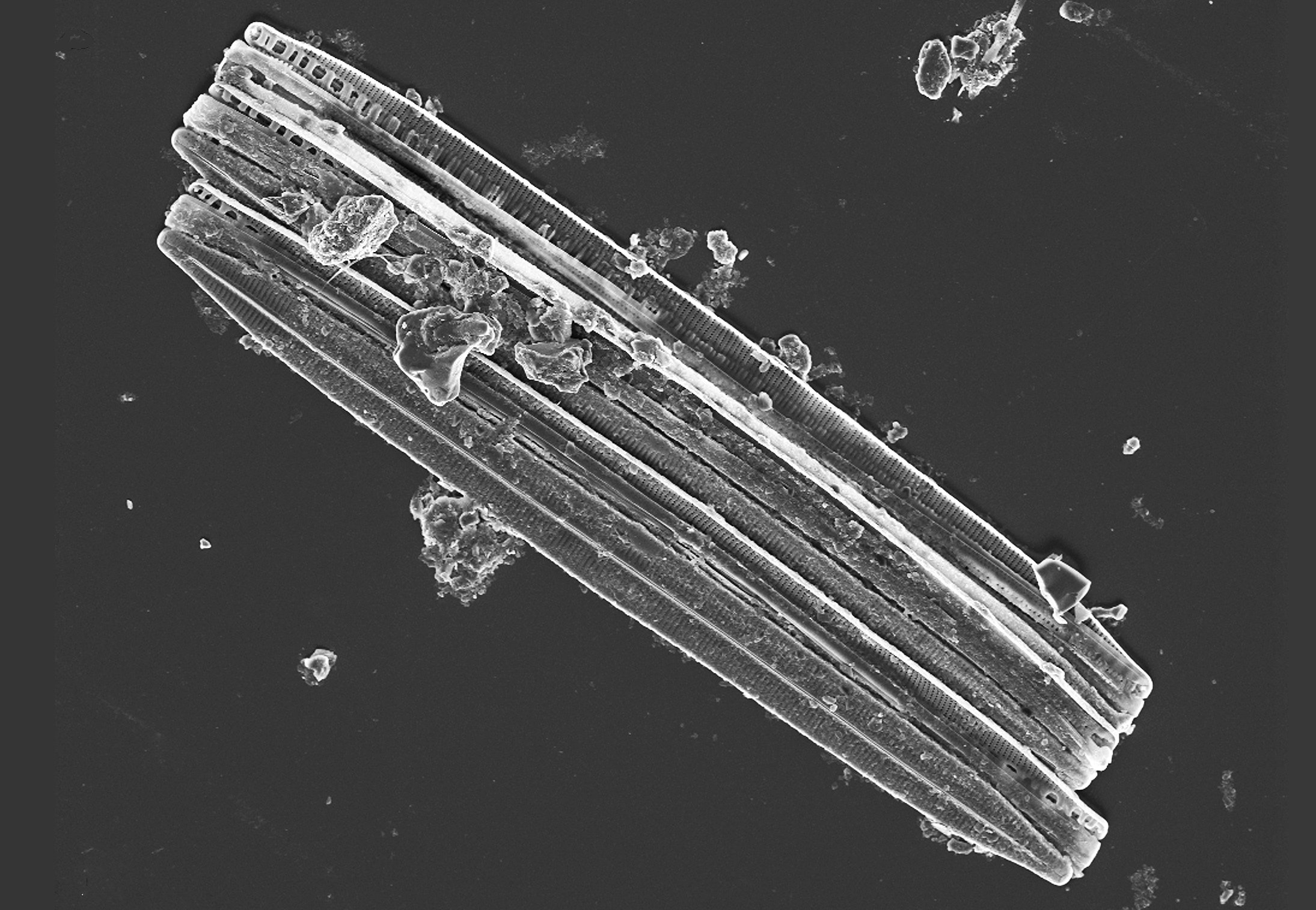Abstract
Two new species in the genus Bacillaria, B. sinensis sp. nov. and B. dongtingensis sp. nov., are described from Dongting Lake, China. Both share the linear-lanceolate valve outline and the fault sites (i.e., branching and/or fusion of transapical ribs), the latter a character of the genus. Even though B. sinensis and B. dongtingensis are found at the same specific locality (sympatric), they differ by two characters: (1) the valves of B. sinensis have asymmetrical flanges on both sides of the raphe, while the raphe flange of B. dongtingensis is only on one side of the raphe; and (2) the valves of B. sinensis lack spines on the valve margins while B. dongtingensis has spines on both margins. Bacillaria sinensis and B. dongtingensis both possess two forms of fault sites on the same valves, i.e., they have both branching of transapical ribs and fusion of transapical ribs on the broader side of valve. This feature is not found in other species of Bacillaria, so it is unique. Bacillaria sinensis and B. dongtingensis are the first two species of Bacillaria reported from a typical and ‘normal’ freshwater habitat.
References
<p>Bory de Saint-Vincent, J.B.G.M. (1822) Bacillarées. <em>Dictionaire Classique d‘Histoire Naturelle</em> 2: 127–129.</p>
<p>Cleve, P.T. & Grunow, A. (1880) Beiträge zur Kenntnis der Arctischen Diatomeen. <em>Kongliga Svenska-Vetenskaps-Akademiens Handlingar</em> 17: 1–121.</p>
<p>Cox, E.J. (2015) Coscinodiscophyceae, Mediophyceae, Fragilariophyceae, Bacillariophyceae (Diatoms). <em>In: </em>Frey, W. (Ed.) <em>Syllabus of plant families. Adolf Engler’s Syllabus der Pflanzenfamilien. Photoautotrophic eukaryotic algae Glaucocystophyta, Cryptophyta, Dinophyta/Dinozoa, Heterokontophyta/Ochrophyta, Chlorarachniophyta/Cercozoa, Euglenophyta/Euglenozoa, Chlorophyta, Streptophyta p.p</em>. 13th ed., 2 (1). Borntraeger Science Publishers, Stuttgart, pp. 64–103.</p>
<p>Cui, M., Zhou, J.X. & Huang, B. (2012) Benefit evaluation of wetlands resource with different modes of protection and utilization in the Dongting Lake region. <em>Procedia environmental sciences</em> 13: 2–17. https://doi.org/10.1016/j.proenv.2012.01.001</p>
<p>Gmelin, J.F. (1788) <em>Carolia Linne Systema Naturae per regna tria naturae secundum classes, ordines, genera species cum characteribus, differentiis, synonymis, locis</em>. Ed. 13. Tomus I (6). Impensis Georg Emanuel Beer, Lipsiae, pp. 3021–4120. [https://www.biodiversitylibrary.org/page/25743606#page/5/mode/1up]</p>
<p>Hassall, A.H. (1845) <em>A history of the British freshwater algae, including descriptions of the Desmideae and Diatomaceae</em>, <em>with upwards of one hundred plates, illustrating the various species. </em>I. Highley, London, 462 pp. https://doi.org/10.5962/bhl.title.22609</p>
<p>Hendey, N.I. (1951) Littoral diatoms of Chichester Harbour with special reference to fouling. <em>Journal of the Royal Microscopical Society</em> 71: 1–86. https://doi.org/10.1111/j.1365-2818.1951.tb01951.x</p>
<p>Jahn, R. & Schmid, A.-M.M. (2007) Revision of the brackish-freshwater diatom genus <em>Bacillaria</em> Gmelin (Bacillariophyta) with the description of a new variety and two new species. <em>European Journal of Phycology</em> 42: 295–312. https://doi.org/10.1080/09670260701428864</p>
<p>Liu, B., Williams, D.M. & Ector, L. (2018) <em>Entomoneis triundulata</em> <em>sp. nov.</em> (Bacillariophyta), a new freshwater diatom species from Dongting Lake, China. <em>Cryptogamie, Algologie</em> 39: 239–253. https://doi.org/10.7872/crya/v39.iss2.2018.239</p>
<p>Liu, B., Williams D.M., Blanco S., Liu Z.-X. & Liu, D. (2019) Three new species of <em>Ulnaria</em> (Kützing) Compère (Bacillariophyta) from China, with reference to the fine structure of their valvocopula. <em>Cryptogamie, Algologie</em> 40: 119–139. https://doi.org/10.5252/cryptogamie-algologie2019v40a11.</p>
<p>Mann, D.G., McDonald, S.M., Bayer, M.M., Droop, S.J., Chepurnov, V.A., Loke, R.E., Ciobanu, A. & Du Buf, J.H. (2004) The <em>Sellaphora</em> <em>pupula</em> species complex (Bacillariophyceae): morphometric analysis, ultrastructure and mating data provide evidence for five new species. <em>Phycologia</em> 43: 459–482. https://doi.org/10.2216/i0031-8884-43-4-459.1</p>
<p>Mann, D.G., Trobajo, R., Sato, S., Li, C, Witkowski, A., Rimet, F., Ashworth, M.P., Hollands, R.M, Theriot, E.C. (2021) Ripe for reassessment: A synthesis of available molecular data for the speciose diatom family Bacillariaceae. <em>Molecular Phylogenetics & Evolution</em> 158: 106985. https://doi.org/10.1016/j.ympev.2020.106985</p>
<p>Marsson, T. (1901) Diatomaceen von Neu-Vorpommern, Rügen und Usedom. <em>Zeitschrift für Angewandte Mikroskopie und Klinische Chemie</em> 6: 253–268.</p>
<p>Mereschkowsky, C. (1902) On <em>Sellaphora</em>, a new genus of diatoms. <em>Annals and Magazine of Natural History</em>, <em>Series 7 </em>9: 185–195. http://doi.org/10.1080/00222930208678565</p>
<p>Müller, O.F. (1786) <em>Animalcula infusoria fluviatilia et marina quae detexit, systematice, descripsit et ad vivum delineare curavit O.F. Muller</em>. N. Möller, Havniae. 373 pp. https://doi.org/10.5962/bhl.title.129933</p>
<p>Round, F.E., Crawford, R.M. & Mann, D.G. (1990) <em>The diatoms: biology and morphology of the genera</em>. Cambridge University Press, Cambridge, 747 pp.</p>
<p>Schmid, A.-M.M. (2007) The “Paradox” Diatom <em>Bacillaria Paxillifer</em> (Bacillariophyta) Revisited. <em>Journal of Phycology</em> 43: 139–155. https://doi.org/10.1111/j.1529-8817.2006.00299.x</p>
<p>Smith, W. (1853) <em>Synopsis of British Diatomaceae</em>. John Van Voorst, London, 89 pp.</p>
<p>Spaulding, S. (2018) <em>Bacillaria paxillifera</em>. In Diatoms of North America. Retrieved April 20, 2021 from [https://diatoms.org/species/bacillaria_paxillifera]</p>
<p>Turpin, P.J.F. (1828) Observations sur le nouveau genre <em>Surirella</em>. <em>Mémoires du Museum d’Histoire Naturelle</em> 16: 361–368.</p>
<p>Witkowski, A., Lange-Bertalot, H. & Metzeltin, D. (2000) Diatom flora of marine coasts I. <em>Iconographia Diatomologica</em> 7. pp. 925.</p>


